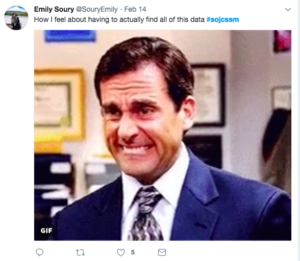By: Kayla Henderson-Wood, Lauren Muniz, Kurtis Copper and Lola Butcher
On Wednesday Kelli Matthews gave a class demonstration on how she would present a professional social media audit to her clients. The example we studied was a website for a real estate company who wanted to better understand its media engagement and improve its tactics. The class discussed how millennials felt about face to face engagement verses over social media and further thought about how this might affect their business.
At a first glance, a few things were quickly noticed and surprisingly they weren’t all good. Here are the major “NOs” when trying to effectively engage people online!

- NO Generic, Low Quality, Stock Photos
- NO Long Captions
- NO Stupid Holiday Pictures
Kelli suggested we use “Topic Buckets” to group together different posts. Diving deeper may seem challenging because of the influx of information a company can generate online. With different buckets, we were able to analyze what information was received well by the audience and what areas could use some improvements. When looking at data it’s important to consider major one-time events or dominating groups that may obscure your information. These would be viewed as an outlier or “reaching” data and would not accurately represent the trends of the businesses day-to-day media engagement.
We replicated the class activity and analyzed our own twitter transcript for our management day (February 14th).
Here’s are top 5 buckets for #SOJCssm:
We understood that a number of the major conversations centered around the discussion about millennial communication and that often student’s witty Gifs + tweets often caught the attention of their peers. Creating buckets is a simple first step to any media audit!
 Kayla Henderson-Wood @Khendersonwood
Kayla Henderson-Wood @Khendersonwood
Kurtis Cooper @KurtzBlurtz
Lauren Muniz @xolaurenmuniz
Lola Butcher @lola_butcher





Hi Kayla! Great post. I think you summarized this class discussion very clearly. I personally loved exploring how to most effectively conduct a social media audit. Sometimes starting seems daunting, given the amount of information that must be organized and interpreted. Looking back on past social media audits I have done for various classes I wish I had known to organize the content into “buckets”. Knowing what we learned in this discussion how would you have done social media audits you’ve done in the past differently?